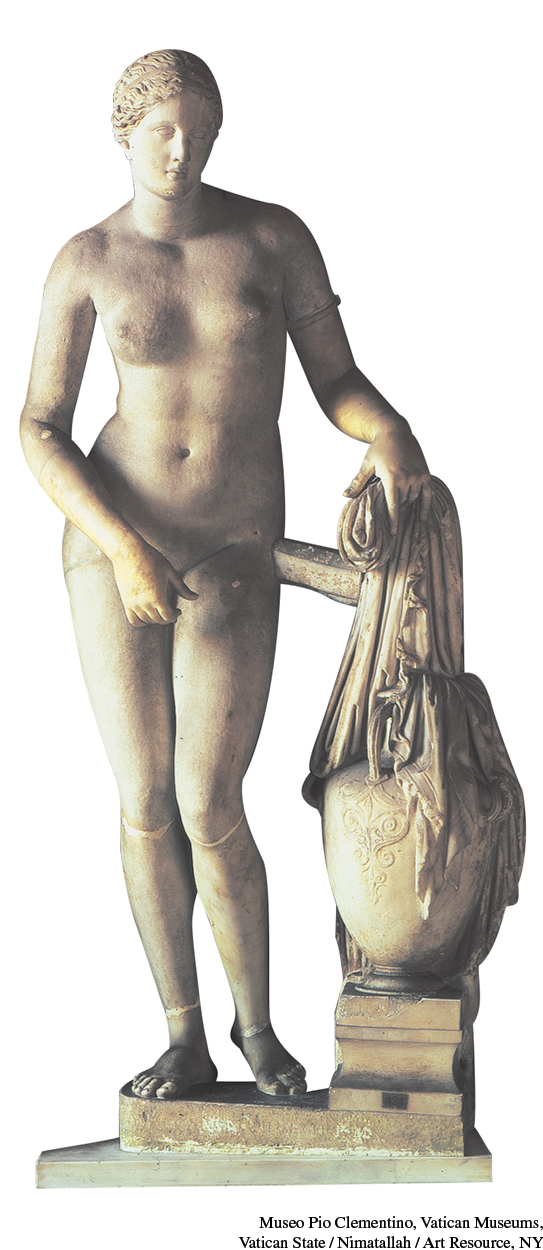The Arts under Royal Support
Printed Page 129
Important EventsThe Arts under Royal Support
Hellenistic kings became the supporters of scholarship and the arts on a vast scale, competing with one another to lure the best scholars and artists to their capitals with lavish salaries. They funded intellectuals and artists because they wanted to boost their reputations by having these famous people produce books, poems, sculptures, and other prestigious creations at their courts.

The Ptolemies turned Alexandria into the Mediterranean’s leading arts and sciences center, establishing the world’s first scholarly research institute and a massive library. The librarians were instructed to collect all the books in the world. The library grew to hold half a million scrolls, an enormous number for the time. Linked to it was the building in which the hired research scholars dined together and produced encyclopedias of knowledge such as The Wonders of the World and On the Rivers of Europe. We still use the name of the research institute’s building, the Museum (“place of the Muses,” the Greek goddesses of learning and the arts), to designate institutions preserving knowledge.
The writers and artists paid by Hellenistic kings had to please their paymasters. The poet Theocritus (c. 300–260 B.C.E.) spelled out the deal underlying royal support in a poem flattering King Ptolemy II: “The spokesmen of the Muses [that is, poets] celebrate Ptolemy in return for his benefactions.” Poets such as Theocritus avoided political topics and exploited the social gap that existed between the intellectual elite—to which the kings belonged—and the uneducated masses. They filled their new poetry with erudite references to make it difficult to understand and therefore exclusive. Only people with a deep literary education could appreciate the mythological allusions that studded these authors’ elaborate poems.
No Hellenistic women poets seem to have enjoyed royal financial support; rather, they created their art independently. They excelled in writing epigrams, short poems in the style of those originally used on tombstones to remember the dead. Highly literary poems by women from diverse regions of the Hellenistic world still survive. Many epigrams were about women, from courtesans to respectable matrons, and the writer’s personal feelings. No other Hellenistic literature better conveys the depth of human emotion than the epigrams written by women poets. (See “Document 4.2: Epigrams by Women Poets.”)
Hellenistic comedies also emphasized stories about emotions and stayed away from politics. Comic playwrights presented plays concerning the troubles of fictional lovers. These comedies became enormously popular because, like modern situation comedies (sitcoms), they offered humorous views of daily life. Papyrus discoveries have restored previously lost comedies of Menander (c. 342–289 B.C.E.), the most famous Hellenistic comic poet, noted for his skill in depicting human personality. Hellenistic tragedy could take a multicultural approach: Ezechiel, a Jew living in Alexandria, wrote Exodus, a tragedy in Greek about Moses leading the Hebrews out of captivity in Egypt.
Hellenistic sculptors and painters featured emotions in their works as well. Classical artists had given their subjects’ faces an idealized serenity, but now Hellenistic sculptures depicted intense personal feelings. Athletes, for example, could be shown realistically as exhausted and scarred by the exertion required to compete at a high level. (See “Seeing History: Showing Struggle and Pain in Hellenistic Sculpture.”)
The increasing diversity of subjects that emerged in Hellenistic art presumably represented a trend approved by kings, queens, and the elites. Sculpture best reveals this new preference for depicting people who had never before appeared in art: heartbreaking victims of war, drunkards, battered athletes, wrinkled old people. The female nude became common. A statue of Aphrodite by Praxiteles, which portrayed the goddess completely naked for the first time, became renowned as a religious object and also a tourist attraction in the city of Cnidos, which had commissioned it. The king of Bithynia offered to pay off the citizens’ entire public debt if he could have the work of art. They refused.